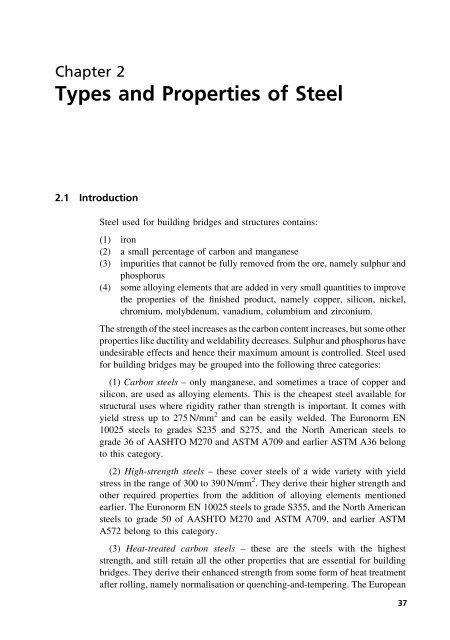The Design of Modern Steel Bridges - TEDI
The Design of Modern Steel Bridges - TEDI
The Design of Modern Steel Bridges - TEDI
Create successful ePaper yourself
Turn your PDF publications into a flip-book with our unique Google optimized e-Paper software.
Chapter 2<br />
Types and Properties <strong>of</strong> <strong>Steel</strong><br />
2.1 Introduction<br />
<strong>Steel</strong> used for building bridges and structures contains:<br />
(1) iron<br />
(2) a small percentage <strong>of</strong> carbon and manganese<br />
(3) impurities that cannot be fully removed from the ore, namely sulphur and<br />
phosphorus<br />
(4) some alloying elements that are added in very small quantities to improve<br />
the properties <strong>of</strong> the finished product, namely copper, silicon, nickel,<br />
chromium, molybdenum, vanadium, columbium and zirconium.<br />
<strong>The</strong> strength <strong>of</strong> the steel increases as the carbon content increases, but some other<br />
properties like ductility and weldability decreases. Sulphur and phosphorus have<br />
undesirable effects and hence their maximum amount is controlled. <strong>Steel</strong> used<br />
for building bridges may be grouped into the following three categories:<br />
(1) Carbon steels – only manganese, and sometimes a trace <strong>of</strong> copper and<br />
silicon, are used as alloying elements. This is the cheapest steel available for<br />
structural uses where rigidity rather than strength is important. It comes with<br />
yield stress up to 275 N/mm 2 and can be easily welded. <strong>The</strong> Euronorm EN<br />
10025 steels to grades S235 and S275, and the North American steels to<br />
grade 36 <strong>of</strong> AASHTO M270 and ASTM A709 and earlier ASTM A36 belong<br />
to this category.<br />
(2) High-strength steels – these cover steels <strong>of</strong> a wide variety with yield<br />
stress in the range <strong>of</strong> 300 to 390 N/mm 2 . <strong>The</strong>y derive their higher strength and<br />
other required properties from the addition <strong>of</strong> alloying elements mentioned<br />
earlier. <strong>The</strong> Euronorm EN 10025 steels to grade S355, and the North American<br />
steels to grade 50 <strong>of</strong> AASHTO M270 and ASTM A709, and earlier ASTM<br />
A572 belong to this category.<br />
(3) Heat-treated carbon steels – these are the steels with the highest<br />
strength, and still retain all the other properties that are essential for building<br />
bridges. <strong>The</strong>y derive their enhanced strength from some form <strong>of</strong> heat treatment<br />
after rolling, namely normalisation or quenching-and-tempering. <strong>The</strong> European<br />
37


